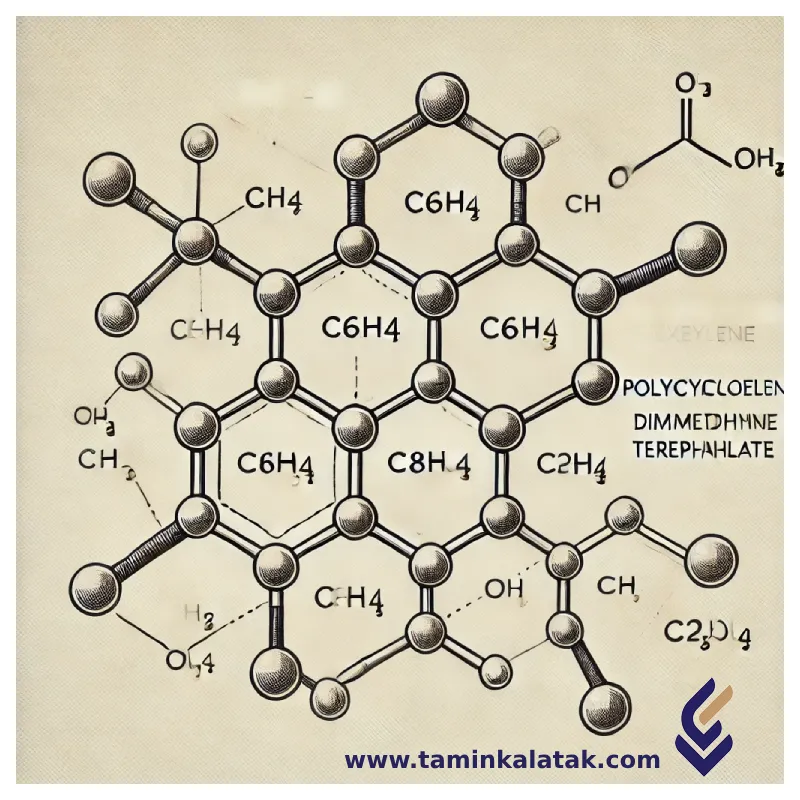Polymers are made up of very large molecules made up of many repeating units called monomers, which ultimately form this long polymer chain
Engineering polymers are high-performance plastics that exhibit superior mechanical, thermal, chemical, and electrical properties compared to standard commodity plastics.
Polycy Clohexylene dimethylene Terephthalate (PCT-G)
Poly(methyl methacrylate) (PMMA), commonly known as acrylic or by brand names like Plexiglas, Lucite, and Perspex, is a synthetic polymer made from the polymerization of methyl methacrylate (MMA) monomers. It is a transparent thermoplastic material widely used in various industries due to its optical clarity, durability, and versatility.
Structure
The structure of Poly(methyl methacrylate) (PMMA) is based on the polymerization of methyl methacrylate (MMA) monomers. Each MMA monomer consists of a methacrylate group, which contains a carbon-carbon double bond (C=C) attached to a methyl group (CH3) and a methoxycarbonyl group (COO). During polymerization, the double bonds of the MMA monomers open up, linking the monomers into long chains. This process results in a polymer backbone of repeating units, where each unit contains a carbon atom bonded to a methyl group and a carbonyl group, forming a structure like -[CH2-C(CH3)COO]-. This repeating unit gives PMMA its characteristics, including its optical clarity, rigidity, and resistance to UV degradation. The polymerization creates a linear or branched structure that is highly crystalline or amorphous, depending on the processing conditions, which contributes to PMMA’s strength and transparency.
Properties
Poly(methyl methacrylate) (PMMA) is a versatile and widely used polymer with several notable properties. It is known for its excellent optical clarity and transparency, often being used as a lightweight alternative to glass in applications such as windows, displays, and lenses. PMMA has good weather resistance, including UV stability, which helps prevent degradation, yellowing, or brittleness when exposed to sunlight. It is also relatively lightweight compared to glass, which makes it an attractive choice in applications where weight reduction is important. Additionally, PMMA has moderate chemical resistance, although it is susceptible to attack by strong acids, bases, and solvents like acetone. The material has a relatively high rigidity, making it resistant to deformation under normal conditions, though it is more brittle than other plastics such as polycarbonate. PMMA also has good electrical insulating properties and can be easily processed through methods like extrusion, injection molding, and casting. However, it is prone to scratching and requires careful handling or coating to maintain its clarity. Despite its brittleness, PMMA remains a popular choice due to its balance of clarity, weather resistance, and versatility.
Applications of Poly Methyl Meth Acrylate (PMMA)
- Optical Lenses: Used in eyeglasses, camera lenses, and optical devices due to its excellent transparency and clarity.
- Signage and Displays: Commonly used in illuminated signs, point-of-purchase displays, and advertising displays.
- Automotive: Used in automotive lighting, such as headlights and tail lights, and in the production of interior and exterior parts.
- Aerospace: Applied in aircraft windows, cockpit covers, and light fixtures for its light weight and optical properties.
- Construction: Used in windows, skylights, facades, and other building materials as a glass alternative due to its durability and weather resistance.
- Medical: Used in intraocular lenses (IOLs), bone cement, and other medical devices for its biocompatibility and clarity.
- Aquarium Panels: Popular in large aquariums and tanks as a transparent, lightweight alternative to glass.
- Furniture: Applied in the production of furniture, particularly in modern or minimalist designs for tables, chairs, and partitions.
Advantages of Poly Methyl Meth Acrylate (PMMA)
- High Transparency: PMMA is highly transparent, making it an excellent choice for optical and display applications.
- Lightweight: PMMA is significantly lighter than glass, which makes it easier to handle and install, reducing overall weight in many applications.
- UV and Weather Resistance: PMMA has strong UV resistance, preventing yellowing and degradation when exposed to sunlight, making it suitable for outdoor applications.
- Good Chemical Resistance: It is resistant to many common chemicals and environmental factors, which makes it durable in a wide range of conditions.
- Ease of Processing: PMMA can be easily processed through various methods such as extrusion, injection molding, and casting, allowing for flexibility in design.
- Versatile: It can be used in a wide range of industries, from medical and aerospace to consumer products, showcasing its broad utility.
Disadvantages of Poly Methyl Meth Acrylate (PMMA)
- Brittleness: PMMA is more brittle compared to other plastics like polycarbonate, which makes it prone to cracking or breaking under impact.
- Scratch Sensitivity: It is more easily scratched than other materials, which can degrade its appearance and clarity over time.
- Chemical Sensitivity: While it has good chemical resistance, PMMA can still be affected by strong acids, bases, and some solvents like acetone.
- Low Impact Resistance: PMMA is less impact-resistant than other materials like polycarbonate, making it less suitable for high-stress applications.
- Limited Flexibility: PMMA is relatively rigid and can be prone to shattering under stress, which limits its use in applications that require flexibility or higher durability.
Applications
| Applications | , , , , |
|---|
Polycy Clohexylene dimethylene Terephthalate
| Products | MFI(g/10 min) | Density (g/Cm³) | Applications | Process method | Data Sheet | MSDS |
|---|---|---|---|---|---|---|
| PCT-G | 5-25 | 1.23-1.31 | Medical devices Food packaging Cosmetic containers,LED reflectors and light guides | Injection Molding, Extrusion, Blow Molding |







